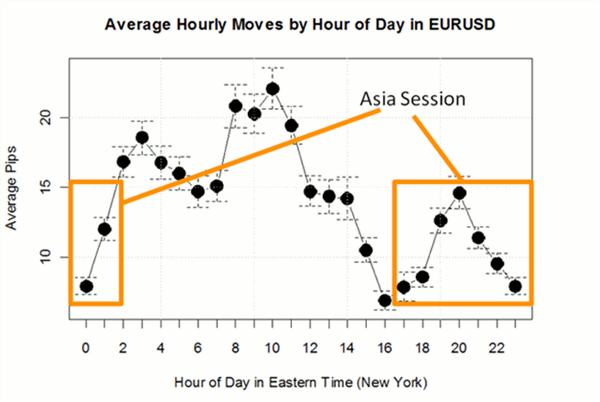In a previous article, we discussed strategies for trading the London session. The Asian Trading session is also an excellent time to trade currency. This article will walk through the nuances and traits of this trading period, while providing ideas and strategies for traders use when ‘Trading Tokyo.’
Some traders from the United States look at the Asian trading session begrudgingly. After the numerous pips that can be mounted (or lost) during the more volatile London and US sessions, those traders are left wanting more.
The Asian trading session is typified by small movements, decreased volatility, and potentially more stringent adherence to pre-established support and resistance levels (with smaller probabilities of ‘breakouts’.)
This would be akin to someone saying they didn’t like buffets simply because there were too many healthy options. After all, you don’t have to eat that tofu—you can always go and buy a steak if you want it; much in the same way you don’t have to take a trade during the Asian session.
But luckily the similarities between trading and tofu pretty much end there, and the Asian trading session offers liquidity to the FX market after the US exchanges close their doors for the day at 5 p.m., until London opens the following morning at 3 a.m. This leaves a pocket of ten hours in which traders can stage an approach in what is, typically, a more ‘quiet’ market.
Slow and Low
Because the primary liquidity coming into the market is from Asia, movements in general can be quite a bit smaller than what will be seen during the London or US sessions.
In the DailyFX Traits of Successful Traders series, Quantitative Strategist David Rodriguez takes a closer look at how volatile currencies can be throughout the day. The findings absolutely confirm the fact that currencies—in general—move less during Asia.
In the chart below, David is examining the most popular currency pair in the world to service as a proxy for this test of volatility.
From the graph, we can see the "average hourly move" made by the EUR/USD currency pair over the tested period was lowest at 4 p.m. Eastern time, shortly ahead of the opening in Sydney.
As liquidity continues to be fed into the market over the hours that follow, we can notice that the "average move" stays quite a bit lower than what is seen during the more active times of the day, such as the London open at 3 a.m., or the beginning of the London/US overlap at 8 a.m. Eastern.
This leads many traders to feel that the Asian session is "unexciting," or maybe even difficult to trade. Those two facets couldn’t be more unrelated. As a matter of fact, the quiet nature of the Asian session may allow traders to more functionally manage their trades. The slow nature of the market can potentially allow for more thorough analysis of risk and reward.
In the Traits of Successful Traders series, David began by examining trader profitability throughout the day. (You can certainly hit the source link for more thorough information.)
The contrast in trader profitability on the major currency pairs is drastic. Traders during the Asian Session showed far better results than traders during the more volatile US and London sessions.
The reasons for this can be numerous, key of which is the "slow and low" nature of the FX market during Asian-trading. Because price movements are less volatile, and average hourly moves are smaller, support and resistance has a tendency to hold more consistently.
David explains: “Most individual Forex traders use ‘range trading’ strategies—buying oversold currencies near support and selling overbought currencies near resistance. These tend to work well during low-volatility times, when support and resistance tends to hold.”
How to Trade Ranges During the Asian Session
The art of trading ranges very much revolves around prudence. Traders looking to buy would want to buy when price is "cheap," preferably when price can be looked at as both cheap and close to support.
This support would allow traders to confidently place a stop, so that if price continues to respect that range, profit on the trade should be realized. A break of that support (and thereby hitting the stop) should be somewhat of a surprise. After all, if the trader is expecting support to be broken, they should probably be looking to trade breakouts.
Because traders entering in ranges have an element of support underneath buy positions (and resistance above sell positions), traders have a very cogent mannerism of capping their risk in effort to avoid losing too much on any individual trade. That mistake, combined with traders losing far more when they are wrong than they make when they are right, can be addressed by traders looking to speculate on ranges, by instituting the advice of Quantitative Strategist David Rodriguez from the aforementioned article:
“Traders are right more than 50% of the time, but lose more money on losing trades than they win on winning trades," he says. "Traders should use stops and limits to enforce a risk/reward ratio of 1:1 or higher.”
James Stanley can be found at DailyFX.com.






















